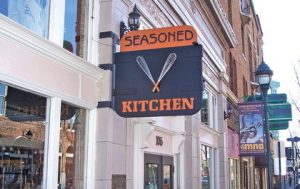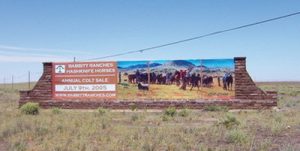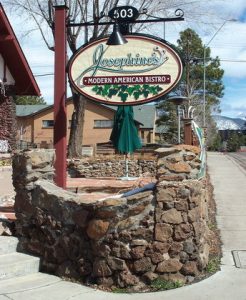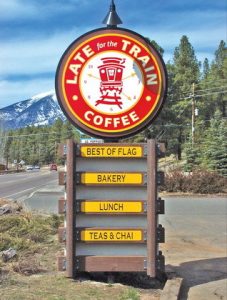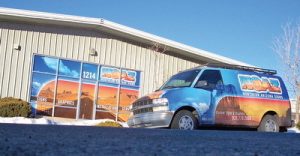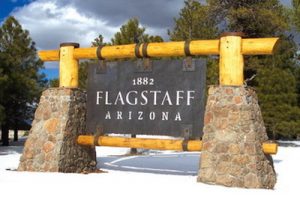Metal Fabrication
Signage With An Altitude
Northern Arizona Signs
Published
15 years agoon
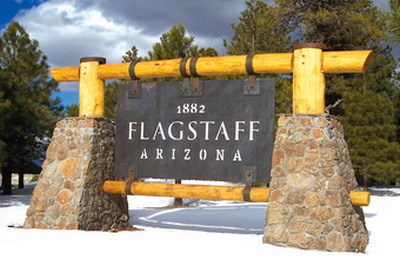
Many signmakers featured in this column chose the sign industry out of happenstance, a career change or because straddling art and craftsmanship would provide a satisfying career. For Phil Keesee, general manager for Flagstaff, AZ- based Northern Arizona Signs (NOAZ), no such epiphany was required – it was in his DNA. His father, Larry, worked as art director for Phoenix, AZ-based SmithCraft Signs and operated his own signshop, Graphics Hardware, which he ultimately sold to SmithCraft.
“I started working at SmithCraft part-time when I was 15,” Keesee said. “I enjoyed the problemsolving aspects of the sign industry, as well as the craft in general.”
Initially, he sought a different path. As a student at Glendale Community College and Arizona State University in the late ’80s, he majored in computer science. However, when he decided a lifetime of binary codes and information packets didn’t seem a fulfilling career, he left school for SmithCraft. For several years as a fabricator, he and his crew handled most of the shop’s graphic design and routing projects, and was later promoted to graphics supervisor.
Setting up shop
In 1997, Keesee earned a golden opportunity. SmithCraft’ opened a new Flagstaff shop and tabbed Keesee to manage the new location, which became NOAZ. His hands-on industry experience and firsthand observation of industry trends served him well.
Advertisement“When I worked at SmithCraft, demand was gradually growing for four-color process, and we wanted to create a division to create the work in-house” Keesee said. “But, I could see that, as printing technology improved, this would become a growing trend.”
After six months of constant commutes from Phoenix to Flagstaff, he opened NOAZ. In its formative years, the shop handled significant photo printing and reproduction because there wasn’t competition. However, when Kinko’s and similar production-copy shops established Flagstaff locations, the shop concentrated solely on signmaking. To ply its trade, the shop uses two Mimaki printers, a JV3 and a JV33, a 60-in. Seal laminator, an HP 5500 DesignJet, a Gerber Sabre 408 router and Odyssey cutting plotter, and a 55-ft. Elliott lift.
“YESCO handled larger electrical-sign installations, and there were small shops that handled basic banner and decal needs,” he said. “So, we strived to find a full-service niche that served a broad swath of customers.”
Serving the public
Symbiotically, NOAZ doesn’t fabricate electric signs, but it installs them, whereas SmithCraft delegates digital-graphics fabrication to its sister company.
Advertisement“We’re very happy with the efficiency of our operation,” Keesee said. “Each shop relies on its core competencies, yet offers a full range of signage and graphics to its customers.”
Local and regional installations for such national sign companies as Federal Heath and Persona represent a significant portion of their business. However, a tough economy and the demise of several sign-industry titans, such as Collins and, more recently, ImagePoint, has somewhat crimped this workload.
“There was a time when installations for national companies represented close to half our business,” he said. “It’s still important to us, but I’d estimate it now amounts to perhaps 25% of our volume of work. They used to ask us to rush jobs while buildings were being constructed; now, it’s much more common that we’re asked to cover up the signs because financial problems have delayed building construction.”
NOAZ doesn’t favor one market segment over another; Flagstaff’s corporate, government and educational milieu offer myriad opportunities. The city’s proximity to the Grand Canyon –approximately 50 miles south of its South Rim – translates into a broad complement of hotels, restaurants and other tourist-friendly businesses. Also, the “Mother Road,” Route 66, passes through Flagstaff and attracts Americana buffs.
AdvertisementKeesee said he fabricated one of his favorite downtown Flagstaff signs for The Seasoned Kitchen, a restaurant-supply store. Although his father retired from SmithCraft in 2002, Keesee enlisted Larry’s help to design this sign, which features ¼-in.-thick aluminum decorated with a copper and black, powdercoated finish that’s sandwiched between flat-cutout, powdercoated-aluminum layers and installed in the building’s existing brackets.
“The brackets were somewhat strangely shaped, so, to fit them and impart a restaurant theme, we built a pot-shaped main panel,” he said. “The owner donated the whisks, which we covered with 3M copper film.”
NOAZ also created a distinctive pole sign for Late for the Train, a coffeehouse located in a former Flagstaff gas station. Smithcraft fabricated aluminum panels and coated them with Matthews acrylic-polyurethane paint, and NOAZ produced the digital graphics with 3M Controltac vinyl. The customer provided the railroad-track, and NOAZ bolted timber blanks onto them to resemble railroad ties.
Northern Arizona University, which educates approximately 16,000 undergraduate students, has become a periodic NOAZ customer.
Keesee said, “They recently opened a conference center, and we created all interior signage and wayfinding elements for it. The school’s administration and facilities staff has always been very cooperative, and we enjoy working with them when the opportunity arises.”
The shop also collaborated with SmithCraft to build the city’s 15-ft.-tall gateway element. NOAZ built the sign’s log frame, and SmithCraft waterjet-cut the sign’s steel panel before NOAZ assembled the components and installed the system on its masonry base.
The company also produces exhibit graphics, which makes it unique among regional shops. NOAZ has fabricated projects Grand Canyon, Wupatki and Sunset Crater National Parks. He said, “These are fun projects because, unlike a lot of other exhibits, they’re meant to be touched.”
The shop fabricates such programs using Lexjet’s high-performance vinyl, PreLume DisplayFlex overlaminate and GraphicMount white adhesive, and outputs them on the shop’s HP DesignJet 5500 printer.
Growth ahead
NOAZ has grown into its second location, a 5,000-sq.-ft. shop. Approximately 4,000 sq. ft. of this is production space that’s divided into “dirty” (routing, painting) and “clean” (printing, vinyl cutting) areas. The shop fabricates and installs signage throughout the region in such neighboring cities as Williams — another city through which Route 66 passes — Winslow, Page, Holbrook and, to a lesser extent, Sedona. However, Sedona, still a tourism boomtown amidst harsh economic times, stipulates restrictive codes, and a handful of signshops aggressively protect their turf.
With its picturesque setting at approximately 7,000 ft. above sea level, Flagstaff is becoming a popular ski and winter-sports haven. This, coupled with widespread ownership of land by Arizona’s state government, has made private property expensive and somewhat stifled development. Moreover, the city’s sign codes also pose challenges.
“I understand they’re trying to create a certain aesthetic and preserve Flagstaff’s personality,” Keesee said. “But, about a decade ago, the codes became much stricter. Square-footage allowances have gone down and LED messageboards except gas-price displays aren’t allowed. But, it’s better not to make enemies, so I work within the system.”
Although it’s earned less notoriety than in Tucson, the Dark Skies Initiative, which prescribes rigid illumination restrictions, actually initiated in Flagstaff due to the presence of two astronomy observatories. Dark Skies limits the brightness from all lightsources, uplighting is forbidden, and even certain signface colors are restricted.
Despite these challenges, the shop remains busy; banners and other digital graphics remain in demand, and tourism-related industry remains relatively steady. Keesee said, “We have to look for work, which wasn’t necessary until last year, and some projects have scaled down, but we’re uniquely positioned in our market, and I’m confident we’ll weather this storm.”
SPONSORED VIDEO
Introducing the Sign Industry Podcast
The Sign Industry Podcast is a platform for every sign person out there — from the old-timers who bent neon and hand-lettered boats to those venturing into new technologies — we want to get their stories out for everyone to hear. Come join us and listen to stories, learn tricks or techniques, and get insights of what’s to come. We are the world’s second oldest profession. The folks who started the world’s oldest profession needed a sign.
You may like
Advertisement
Subscribe

Magazine
Get the most important news
and business ideas from Signsofthetimes Magazine.
Advertisement
Most Popular
-

 Tip Sheet1 week ago
Tip Sheet1 week agoAlways Brand Yourself and Wear Fewer Hats — Two of April’s Sign Tips
-

 Photo Gallery2 days ago
Photo Gallery2 days ago30 Snapshots of the 2024 ISA Sign Expo
-

 Ask Signs of the Times4 days ago
Ask Signs of the Times4 days agoWhy Are Signs from Canva so Overloaded and Similar?
-

 Real Deal2 weeks ago
Real Deal2 weeks agoA Woman Sign Company Owner Confronts a Sexist Wholesaler
-

 Benchmarks7 days ago
Benchmarks7 days ago6 Sports Venue Signs Deserving a Standing Ovation
-

 Women in Signs2 weeks ago
Women in Signs2 weeks ago2024 Women in Signs: Megan Bradley
-

 Photo Gallery1 week ago
Photo Gallery1 week ago21 Larry Albright Plasma Globes, Crackle Tubes and More
-

 Women in Signs1 week ago
Women in Signs1 week ago2024 Women in Signs: Ashley Borell

